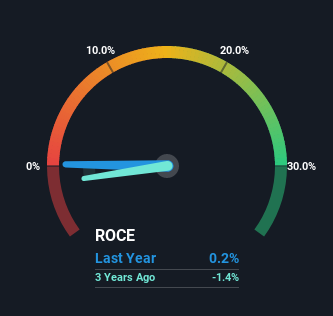- Saudi Arabia
- /
- Chemicals
- /
- SASE:2060
Investors Will Want National Industrialization's (TADAWUL:2060) Growth In ROCE To Persist

Did you know there are some financial metrics that can provide clues of a potential multi-bagger? Typically, we'll want to notice a trend of growing return on capital employed (ROCE) and alongside that, an expanding base of capital employed. If you see this, it typically means it's a company with a great business model and plenty of profitable reinvestment opportunities. With that in mind, we've noticed some promising trends at National Industrialization (TADAWUL:2060) so let's look a bit deeper.
What is Return On Capital Employed (ROCE)?
For those that aren't sure what ROCE is, it measures the amount of pre-tax profits a company can generate from the capital employed in its business. Analysts use this formula to calculate it for National Industrialization:
Return on Capital Employed = Earnings Before Interest and Tax (EBIT) ÷ (Total Assets - Current Liabilities)
0.0016 = ر.س33m ÷ (ر.س26b - ر.س4.6b) (Based on the trailing twelve months to March 2022).
Therefore, National Industrialization has an ROCE of 0.2%. In absolute terms, that's a low return and it also under-performs the Chemicals industry average of 9.7%.
Check out our latest analysis for National Industrialization

In the above chart we have measured National Industrialization's prior ROCE against its prior performance, but the future is arguably more important. If you'd like, you can check out the forecasts from the analysts covering National Industrialization here for free.
The Trend Of ROCE
Like most people, we're pleased that National Industrialization is now generating some pretax earnings. Historically the company was generating losses but as we can see from the latest figures referenced above, they're now earning 0.2% on their capital employed. In regards to capital employed, National Industrialization is using 23% less capital than it was five years ago, which on the surface, can indicate that the business has become more efficient at generating these returns. The reduction could indicate that the company is selling some assets, and considering returns are up, they appear to be selling the right ones.
The Bottom Line On National Industrialization's ROCE
In the end, National Industrialization has proven it's capital allocation skills are good with those higher returns from less amount of capital. Since the stock has only returned 16% to shareholders over the last five years, the promising fundamentals may not be recognized yet by investors. Given that, we'd look further into this stock in case it has more traits that could make it multiply in the long term.
On a final note, we've found 1 warning sign for National Industrialization that we think you should be aware of.
While National Industrialization may not currently earn the highest returns, we've compiled a list of companies that currently earn more than 25% return on equity. Check out this free list here.
Valuation is complex, but we're here to simplify it.
Discover if National Industrialization might be undervalued or overvalued with our detailed analysis, featuring fair value estimates, potential risks, dividends, insider trades, and its financial condition.
Access Free AnalysisHave feedback on this article? Concerned about the content? Get in touch with us directly. Alternatively, email editorial-team (at) simplywallst.com.
This article by Simply Wall St is general in nature. We provide commentary based on historical data and analyst forecasts only using an unbiased methodology and our articles are not intended to be financial advice. It does not constitute a recommendation to buy or sell any stock, and does not take account of your objectives, or your financial situation. We aim to bring you long-term focused analysis driven by fundamental data. Note that our analysis may not factor in the latest price-sensitive company announcements or qualitative material. Simply Wall St has no position in any stocks mentioned.
About SASE:2060
National Industrialization
Operates in the petrochemicals, chemicals, plastics, and metals sectors in the Kingdom of Saudi Arabia, rest of the Middle East, Asia, Africa, Europe, and internationally.
Moderate growth potential and slightly overvalued.
Similar Companies
Market Insights
Community Narratives



